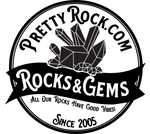Jadeite Filter Instructions

Jadeite filters can be helpful, but are not reliable for determining the identity of a stone. We find them useful when we have looking at a parcel of stones. You can use a jadeite filter to quickly find any stones that are "not like the others."
Step 1: Hold your jadeite filter up over the gemstone(s). I recommend not holding it directly up to your eye, but keeping it about six to eight inches away.
Step 2: Aim a strong light source at the gemstone(s) . Note that the light source should not be aimed through the gemstone(s) into the jadeite filter, that will not work! You must aim the light into the gemstone and it must be strong enough to come back out of the gemstone into the jadeite filter for it to work properly. And it must be strong enough to get some light to pass through the filter itself which is also no small feat. I use a fiber optic light and it works great. In a bind, a flashlight or bulb will work but I get eyestrain that way.
Step 3: Have the gemstone(s) underneath the filter and in the path of the strong light source. I prefer to lay the stones down on something that is bright white to help with light return.
Step 4: There are many different color properties that can be exhibited by gemstones through the jadeite filter. Some gems even have different colors based on the locality where they were found. Above I used the simplest test as an example. The gem rough above is green tourmaline. The jadeite filter displays the stones are red, not green, which means that the green tourmalines contain chromium. With that information in hand, they can be called chrome tourmaline and their value goes up!
I recommend purchasing the book Gem Identification Made Easy to help you learn the many different ways the gemstone color properties through a jadeite filter can help you determine what kind of stone you have. Remember that the color identification is diagnostic, but not conclusive.
Pro Tip:
- Remember no one test is conclusive (especially filter tests!) Alway perform at least 3 tests to determine the type of stone you have.
Some Jadeite Filter Reactions



GREENS
Alexandrite:Red
Aquamarine: Distinctly Green
Aventurine Quartz: Reddish
Chrome Chalcedony: Red
Chrysoprase: Green
Demantoid Garnet: Reddish
Emerald: Pink to Red
Enstatite: Green
Fluorite: Reddish
Glass (Paste): Green
Hiddenite: Slight Pink
Jadeite: Green
Peridot: Green (Aqua Blue)
Sapphire: Green
Stained Bowenite: Red
Stained Chalcedony: Red
Stained Jadeite: Red
Synthetic emerald: Strong Red
Synthetic Sapphire: Red
Synthetic Spinel: Red
Tourmaline: Green (Chrome tourmaline:might be Red)
Tsavorite Ganet: Red
Uvarovite Garnet: Pink
Zircon: Reddish
REDS
Garnets, dark red, no fluorescence Red
Garnet topped doublet , no fluorescence Dark Red
Glass, paste, no fluorescence Reddish
Ruby, natural and synthetic, strong fluorescence The natural and synthetic sapphire are indistinguishable under the color filter) Red
Spinel, fluorescent Red
Spinel, synthetic, fluorescent ( pink synthetic spinel does not show a red color through the filter)
Red
BLUES
Aquamarine Distinctive Green
Garnet topped doublet Greenish-blue
Glass, paste, dark blue Red
Glass, paste, light blue Greenish
Lapis lazuli Weak brownish red
Sapphire, blackish (The Blue sapphire which shows a Purple color under artificial light, usually shows Red under the filter) Green
Sodalite Slightly brownish
Spinel Reddish
Spinel, colored by cobalt Red
Swiss lapis, greenish-blue Greenish blue
Synthetic sapphire (The natural and synthetic sapphire are indistinguishable under the color filter) Dark Greenish Blue
Synthetic Spinel,dark blue Red
Synthetic Spinel, light blue Orange
Synthetic Spinel, zircon color Orange to Red
Synthetic Spinel, lapis lazuli color Bright Red
Zircon Greenish
PURPLES
Amethyst: Reddish
Violet Sapphire: Bright Red
Source for reactions: Gemology Online, Barbra Voltaire The Chelsea Filter



GREENS
Alexandrite:Red
Aquamarine: Distinctly Green
Aventurine Quartz: Reddish
Chrome Chalcedony: Red
Chrysoprase: Green
Demantoid Garnet: Reddish
Emerald: Pink to Red
Enstatite: Green
Fluorite: Reddish
Glass (Paste): Green
Hiddenite: Slight Pink
Jadeite: Green
Peridot: Green (Aqua Blue)
Sapphire: Green
Stained Bowenite: Red
Stained Chalcedony: Red
Stained Jadeite: Red
Synthetic emerald: Strong Red
Synthetic Sapphire: Red
Synthetic Spinel: Red
Tourmaline: Green (Chrome tourmaline:might be Red)
Tsavorite Ganet: Red
Uvarovite Garnet: Pink
Zircon: Reddish
REDS
Garnets, dark red, no fluorescence Red
Garnet topped doublet , no fluorescence Dark Red
Glass, paste, no fluorescence Reddish
Ruby, natural and synthetic, strong fluorescence The natural and synthetic sapphire are indistinguishable under the color filter) Red
Spinel, fluorescent Red
Spinel, synthetic, fluorescent ( pink synthetic spinel does not show a red color through the filter)
Red
BLUES
Aquamarine Distinctive Green
Garnet topped doublet Greenish-blue
Glass, paste, dark blue Red
Glass, paste, light blue Greenish
Lapis lazuli Weak brownish red
Sapphire, blackish (The Blue sapphire which shows a Purple color under artificial light, usually shows Red under the filter) Green
Sodalite Slightly brownish
Spinel Reddish
Spinel, colored by cobalt Red
Swiss lapis, greenish-blue Greenish blue
Synthetic sapphire (The natural and synthetic sapphire are indistinguishable under the color filter) Dark Greenish Blue
Synthetic Spinel,dark blue Red
Synthetic Spinel, light blue Orange
Synthetic Spinel, zircon color Orange to Red
Synthetic Spinel, lapis lazuli color Bright Red
Zircon Greenish
PURPLES
Amethyst: Reddish
Violet Sapphire: Bright Red
Source for reactions: Gemology Online, Barbra Voltaire The Chelsea Filter
